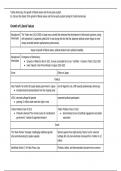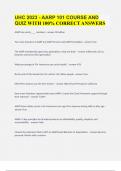week 1 lecture
hoe worden kinderen beinvloed
infants <1jaar
early childhood: toddlers (1-3 jaar) en pre-schoolers (4-5 jaar)
middle childhood 5-12 jaar (tweens van 8-12 gedragen zich weer anders ineens. puberteit)
adolescents early 12-15 jaar(meer puberaal) en late 15-19 jaar
4-6 jaar is echt de transition period naar middle childhood
2005 VS today
start youtube, netflix DVD VS top van youtube en netflix
facebook VS insta snapchat
2% heeft smartphone, start wifi VS 94% heeft smartphone, overal wifi
kids and youth entertainment landscape is changing rapidly
- youtube kids
- tech toys
- virtual toys
in de klas
- tegenwoordig computers ipv papier en pen
- begin van VR
- grote bedrijven hebben scholen als target om hun programmas te gebruiken
- is technologie gunstig, of verhindert het het leerproces?
pediatrics = overal waar kinderen medische of psychologische hulp krijgen
- technologie kan kinderen helpen om vertrouwder te worden met hun behandeling
medicijnen of hulp
- gaming kan ook de pijn minder maken
how much media do youth consume
- de tijd zegt niet alles want het gaat vooral om de inhoud.
- de 3 C’s: content (wat wordt er gekeken), context (wie zit er met het kind, wat
gebeurt er om het kind heen, waarom kijkt het kind het, mag het kind het kijken
blabla), child
—> het gaat om meer dan alleen de schermtijd
als er een elektrisch
apparaat in huis is, gaan
kinderen automatisch
meer gebruiken. Mag ik
op jouw telefoooon?
, wat is age appropriate?
- verschillende leeftijden gebruiken technologie en internet enzo anders.
- andere voorkeuren en interesses
- teens hebben hogere daily screen use dan tweens
- tweens in lagere inkomen huishoudens hebben hogere daily screen use dan hogere
inkomens
verschillen tussen culturen onder teens
- hoogst gebruik US dan UK dan JAPAN
wat moeten we van de veranderingen (meer technologie en gebruik) vinden? is het positief
of negatief?
- vooral in negatief daglicht gezet
- zelfs veroorzakers van de digitale verslaving praten er negatief over
- speculering over negatieve gevolgen well-being door social media
- cyber bullying, naaktfoto’s
- sociale leven verkleind
positieve daglicht
- przybylski et al.: positieve effecten wanneer kinderen apparatuur gebruiken voor
maximaal uur per dag
- ontspanning, stress relief
- kinderen gaan meer lezen
- autistische kinderen kunnen worden geholpen met technologie
- veel apps zijn leerzaam
de negatieve of positieve effecten hangen van allerlei dingen af. je kan het niet zo makkelijk
toeschrijven.
week 2 lecture
hoe worden kinderen beinvloed
infants <1jaar
early childhood: toddlers (1-3 jaar) en pre-schoolers (4-5 jaar)
middle childhood 5-12 jaar (tweens van 8-12 gedragen zich weer anders ineens. puberteit)
adolescents early 12-15 jaar(meer puberaal) en late 15-19 jaar
4-6 jaar is echt de transition period naar middle childhood
2005 VS today
start youtube, netflix DVD VS top van youtube en netflix
facebook VS insta snapchat
2% heeft smartphone, start wifi VS 94% heeft smartphone, overal wifi
kids and youth entertainment landscape is changing rapidly
- youtube kids
- tech toys
- virtual toys
in de klas
- tegenwoordig computers ipv papier en pen
- begin van VR
- grote bedrijven hebben scholen als target om hun programmas te gebruiken
- is technologie gunstig, of verhindert het het leerproces?
pediatrics = overal waar kinderen medische of psychologische hulp krijgen
- technologie kan kinderen helpen om vertrouwder te worden met hun behandeling
medicijnen of hulp
- gaming kan ook de pijn minder maken
how much media do youth consume
- de tijd zegt niet alles want het gaat vooral om de inhoud.
- de 3 C’s: content (wat wordt er gekeken), context (wie zit er met het kind, wat
gebeurt er om het kind heen, waarom kijkt het kind het, mag het kind het kijken
blabla), child
—> het gaat om meer dan alleen de schermtijd
als er een elektrisch
apparaat in huis is, gaan
kinderen automatisch
meer gebruiken. Mag ik
op jouw telefoooon?
, wat is age appropriate?
- verschillende leeftijden gebruiken technologie en internet enzo anders.
- andere voorkeuren en interesses
- teens hebben hogere daily screen use dan tweens
- tweens in lagere inkomen huishoudens hebben hogere daily screen use dan hogere
inkomens
verschillen tussen culturen onder teens
- hoogst gebruik US dan UK dan JAPAN
wat moeten we van de veranderingen (meer technologie en gebruik) vinden? is het positief
of negatief?
- vooral in negatief daglicht gezet
- zelfs veroorzakers van de digitale verslaving praten er negatief over
- speculering over negatieve gevolgen well-being door social media
- cyber bullying, naaktfoto’s
- sociale leven verkleind
positieve daglicht
- przybylski et al.: positieve effecten wanneer kinderen apparatuur gebruiken voor
maximaal uur per dag
- ontspanning, stress relief
- kinderen gaan meer lezen
- autistische kinderen kunnen worden geholpen met technologie
- veel apps zijn leerzaam
de negatieve of positieve effecten hangen van allerlei dingen af. je kan het niet zo makkelijk
toeschrijven.
week 2 lecture



